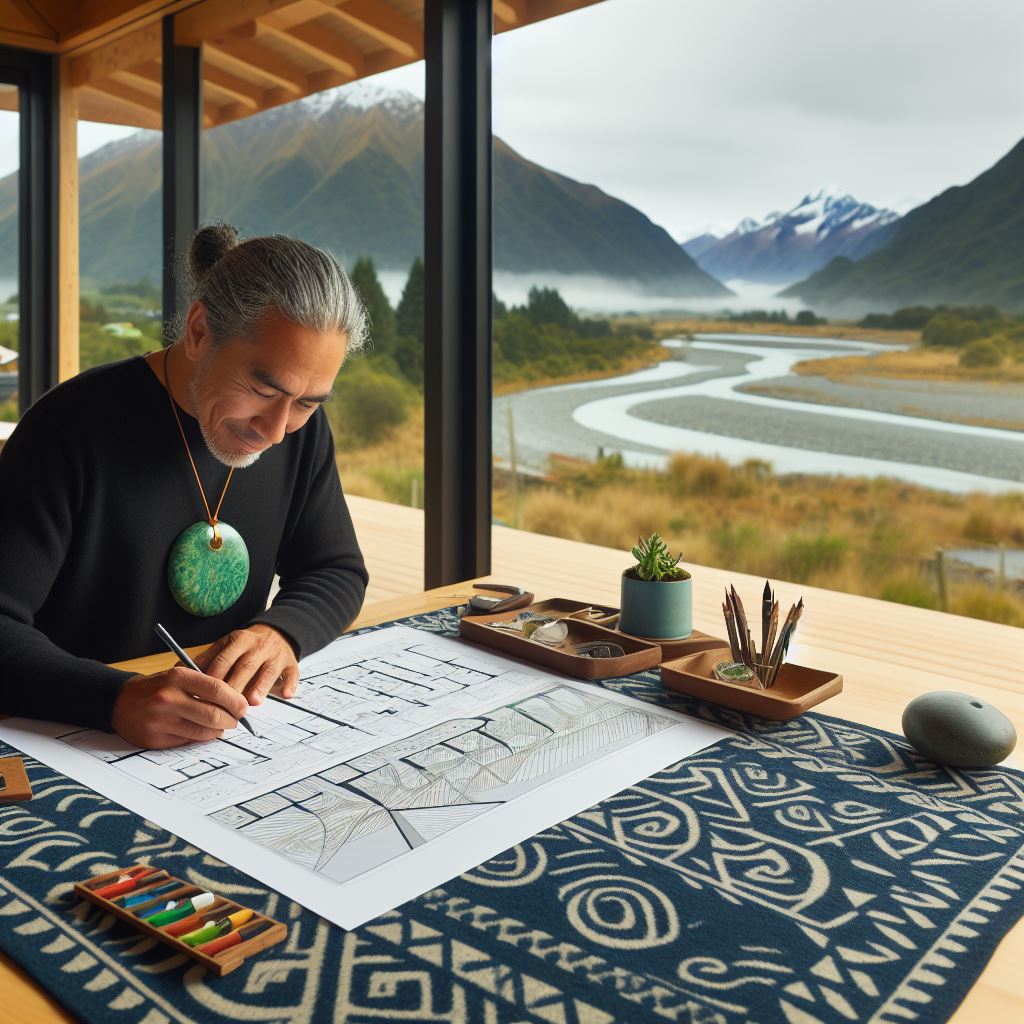Introduction
Being an architect is a popular career choice in New Zealand, and this blog post will provide insights into the daily life of a Kiwi architect.
New Zealand is known for its stunning landscapes and innovative architecture. It’s no wonder that many individuals aspire to become architects in this country.
In this blog post, we will take a closer look at what a typical day looks like for a Kiwi architect. From the moment they wake up to the time they retire to bed, we will explore the challenges, creativity, and dedication that goes into being an architect in New Zealand.
From meeting with clients, brainstorming ideas, and designing structures that blend seamlessly with the environment, an architect’s job is far from ordinary.
We will delve into the various tasks and responsibilities that architects undertake, including site visits, collaborating with builders and contractors, and ensuring that projects meet strict building codes and regulations.
Moreover, we will also discuss the importance of staying updated with the latest industry trends and technologies, attending conferences and workshops to enhance their skills and knowledge.
Throughout this blog post, you will gain a deeper understanding of what it truly means to be a Kiwi architect, the passion they have for their craft, and the impact they make on the built environment in New Zealand.
So join us as we step into the shoes of a Kiwi architect and explore their fascinating and inspiring daily journey.
Education and Training
When it comes to becoming an architect in New Zealand, there are certain educational qualifications that are required.
So, let’s delve into what it takes to pursue a career in architecture in this beautiful country.
Educational Qualifications
- A Bachelor’s degree in architecture is the minimum requirement to enter this profession.
- Several universities in New Zealand offer accredited architecture programs, providing students with a comprehensive education.
- The Bachelor’s degree typically spans for four years, and it serves as a foundation for further specialization.
- Master’s degrees or postgraduate diplomas in architecture are also available for those seeking advanced knowledge.
- Additionally, gaining expertise in related fields such as urban planning or sustainable design can be beneficial.
Practical Experience and Professional Registration
- Acquiring practical experience is essential for aspiring architects in New Zealand.
- After completing the educational requirements, graduates usually join architectural firms for practical training.
- Gaining hands-on experience allows them to apply their theoretical knowledge in real-world scenarios.
- Furthermore, it is necessary to register with the New Zealand Registered Architects Board (NZRAB).
- Registration ensures that architects meet the professional standards set by the industry.
- Being a registered architect provides credibility and legal recognition for practicing architecture in New Zealand.
Ongoing Professional Development
- Architects in New Zealand are encouraged to engage in continuous professional development throughout their careers.
- This helps them stay updated with the latest trends, technologies, and regulations in the field.
- Attending seminars, workshops, and conferences are excellent avenues for architects to further enhance their skills.
- Professional bodies like the New Zealand Institute of Architects (NZIA) provide various development opportunities.
- CPD (Continuing Professional Development) points are awarded to architects for participating in relevant activities.
- These points are crucial for maintaining professional registration and demonstrating a commitment to personal growth.
To summarize, New Zealand requires architects to acquire a minimum Bachelor’s degree in architecture.
Practical experience, gained through working in architectural firms, is crucial for honing skills.
Registration with regulatory bodies ensures compliance with industry standards, while ongoing professional development is vital for staying abreast of advancements.
Read: The Future of Electrical Engineering in NZ
Morning Routine
- A typical morning routine of a Kiwi architect starts with a clear mind and focus.
- Starting the day with a calm and organized mindset is crucial for productivity.
- Catching up on emails is one of the first tasks to ensure effective communication.
- Reviewing project plans helps architects stay on track and maintain their vision.
- Checking project progress ensures that deadlines are met and milestones are achieved.
- In addition, architects may have meetings with clients or team members to discuss project updates.
- Taking a break for a healthy breakfast provides energy and nourishment for the busy day ahead.
- A quick exercise routine, such as stretching or yoga, can boost creativity and focus.
- Throughout the morning, architects may consult with contractors or suppliers to address any issues.
- Juggling multiple projects requires careful time management and prioritization.
- Collaborating with colleagues or attending design workshops can inspire new ideas and perspectives.
- Aspiring Kiwi architects may spend their mornings studying for exams or licensing requirements.
- Attending site visits allows architects to oversee construction progress and address any design challenges.
- Documenting project details and logging hours ensures accurate time tracking and billing.
- The morning routine sets the tone for the rest of the day, shaping productivity and creativity.
- By accomplishing key tasks in the morning, architects can reduce stress and focus on creative design.
- Maintaining a well-structured morning routine is essential for a successful Kiwi architect’s career.
Read: NZ Electrical Engineering: Industry Insights
Personalized Career Consulting
Unlock your potential with expert career advice tailored to your goals. Get personalized guidance and actionable steps toward your dream career in New Zealand.
Get StartedCollaboration and Design
Architects often work in teams with other professionals
Architects, although often seen as the primary creative force behind a project, rarely work alone.
They collaborate with other professionals, such as engineers, interior designers, and contractors, to ensure a successful outcome.
The architectural design process is inherently collaborative.
It involves multiple stakeholders, including the client, who provide input and feedback at different stages.
Through this collaboration, the design evolves and improves, taking into account various perspectives and expertise.
The collaborative nature of the architectural design process
One of the essential aspects of collaboration in architecture is effective communication.
Architects need to convey their vision and ideas clearly to other team members to ensure a cohesive design outcome.
Regular meetings and discussions with the team allow for this exchange of information.
Furthermore, architects often rely on specialized software and technologies to develop and visualize their design concepts.
Computer-Aided Design (CAD) software, for example, enables architects to create precise drawings and 3D models.
Use of specialized software and technologies in creating design concepts
This technology also facilitates collaboration with other team members by allowing them to view and provide feedback on the design.
Changes and revisions can be easily incorporated into the digital model, improving efficiency and reducing errors during the construction phase.
Moreover, collaborative technologies like Building Information Modeling (BIM) enable architects to integrate various aspects of the design, such as structural, mechanical, and electrical systems.
This interdisciplinary approach ensures that all components work together harmoniously.
The collaborative nature of the design process extends beyond the architectural team.
Architects often engage in discussions and negotiations with clients, consultants, and contractors.
This collaboration ensures that the design aligns with the client’s vision, meets regulatory requirements, and stays within budget.
In addition to professionals within the industry, architects may also seek input from the community and end-users.
Public consultations and workshops allow for a broader understanding of the context and the needs of the people who will ultimately use the built environment.
Successful collaboration in architectural design fosters creativity and innovation.
It brings together diverse perspectives and expertise, resulting in designs that are functional, aesthetically pleasing, and sustainable.
The architecture profession recognizes the value of collaboration and actively promotes interdisciplinary teamwork.
In review, architects rarely work in isolation and actively collaborate with other professionals throughout the design process.
Collaboration fosters creativity, ensures effective communication, and facilitates the integration of specialized software and technologies.
Through collaboration, architects create designs that meet the needs of clients, adhere to regulations, and enhance the built environment for the community and end-users.
Site visits and client meetings are crucial aspects of a kiwi architect’s daily routine. These activities play a significant role in ensuring the success and satisfaction of both the architect and the client.
Site visits for architects to assess progress
Site visits are essential for architects to assess the progress of construction projects and make necessary adjustments.
By physically visiting the site, architects can observe the work in progress, identify any potential issues, and ensure that the construction aligns with their design plans.
It allows them to address any concerns or modifications promptly, avoiding delays and costly mistakes.
Additionally, site visits provide architects with a deeper understanding of the context in which their projects are built.
They can assess the impact of the surroundings on their designs, incorporate local elements, and ensure that the built structure harmonizes with the environment.
Overall, site visits enable architects to have a hands-on approach and actively contribute to the realization of their vision.
Role of architects in conducting client meetings
Client meetings are equally vital as they allow architects to understand their clients’ needs and expectations.
Through meaningful conversations, architects gain insights into the client’s lifestyle, preferences, and aspirations for the project.
This understanding serves as a foundation for designing spaces that not only meet the functional requirements but also reflect the client’s personality and desires.
Importance of effective communication and problem-solving skills
During client meetings, effective communication is key.
Architects must actively listen to their clients, ask relevant questions, and provide clear explanations and design options.
By maintaining a collaborative and open-minded approach, architects can build trust and establish strong working relationships with their clients.
This open communication fosters a sense of ownership and ensures that the final design aligns with the client’s vision.
Moreover, client meetings involve problem-solving discussions.
Architects must analyze the challenges and constraints of the project with the client and brainstorm innovative solutions together.
This collaborative problem-solving approach helps architects to gain multiple perspectives and enables them to offer feasible and creative design solutions.
It also ensures that the final design is adaptable and responsive to the client’s evolving needs.
To sum it up, site visits and client meetings are critical components of a kiwi architect’s daily routine.
These interactions allow architects to assess project progress, make adjustments, and address potential issues promptly.
They also enable architects to understand their clients’ needs and expectations, fostering open communication and problem-solving.
By actively engaging in these activities, architects can create exceptional designs that align with their clients’ desires and create spaces that exceed expectations.
Read: How to Become an Electrical Engineer in NZ

Design Development
How architects spend a significant amount of time working on design development
Design development is a crucial part of an architect’s day-to-day work.
Architects spend a significant amount of time on this phase, refining initial designs and incorporating client feedback and project requirements.
Process of refining initial designs based on client feedback and project requirements
- Architects carefully consider the aesthetics of the design during the development phase.
- They strive to create visually appealing structures that align with the client’s vision and the project’s overall goals.
- Aesthetics play a crucial role in attracting occupants, enhancing user experience, and creating a sense of place.
- Architects also prioritize functionality in design development.
- They ensure that the layout and spatial organization of the building meet the specific needs of the users.
- This includes factors such as circulation, accessibility, and efficient use of space.
- Functionality is a key aspect that contributes to the success and usability of the building.
- Sustainability is another crucial consideration for architects during design development.
- They integrate sustainable design principles into their plans to minimize the environmental impact of the building.
- This includes incorporating energy-efficient systems, using sustainable materials, and considering site orientation and natural lighting.
Importance of considering aesthetics, functionality, and sustainability
During the design development phase, architects work closely with clients to refine the initial concepts. They take into account client feedback, suggestions, and project requirements.
- Architects welcome constructive criticism and actively seek input from clients to ensure the design aligns with their expectations.
- They engage in open communication and creative problem-solving to address any concerns or challenges that arise during the process.
- Architects collaborate with other professionals, such as engineers and contractors, to ensure the design is feasible and meets all regulatory requirements.
- They iterate and revise the design as needed to create the best possible outcome for the project.
- Architecture is a highly iterative process, and design development plays a crucial role in achieving a successful final result.
In the end, architects spend a significant amount of time on design development, refining initial designs based on client feedback and project requirements.
They carefully consider aesthetics, functionality, and sustainability during this phase to create visually appealing, user-friendly, and environmentally conscious buildings.
Read: Women in Electrical Engineering in NZ
Transform Your Career with a Professional CV and Cover Letter
Stand out to employers with an ATS-optimized resume and tailored cover letter designed to match your dream role. Let us craft your job application materials for success!
Get StartedProject Management
As a Kiwi architect, project management is one of the key responsibilities I handle on a daily basis.
It involves coordinating various professionals involved in the construction process and ensuring smooth execution from start to finish.
Coordination of Professionals
One of the main tasks in project management is coordinating the efforts of various professionals who contribute to the construction project.
This includes engineers, contractors, interior designers, and landscape architects.
Effective coordination is crucial to ensure that everyone is on the same page and working together towards the common goal of completing the project successfully.
Regular meetings and clear communication channels are essential for effective coordination.
Key Tasks
As a project manager, I am responsible for several key tasks that contribute to the overall success of the project.
Budgeting
One of the first tasks in project management is developing and managing the budget.
This involves estimating costs, creating a financial plan, and monitoring expenses throughout the construction process.
It is important to stay within the allocated budget without compromising on quality.
Scheduling
Creating a realistic and achievable schedule is crucial in project management.
This involves setting deadlines, determining the sequence of activities, and ensuring that resources are allocated efficiently.
Regular monitoring and adjusting of the schedule may be required to overcome unforeseen delays.
Ensuring Compliance
Compliance with building regulations is another vital aspect of project management.
Boost Your Career with a Standout LinkedIn Profile
Attract recruiters and expand your network with a fully optimized LinkedIn profile tailored to highlight your strengths and professional goals. Let your profile open doors to new opportunities!
Get OptimizedKiwi architects must ensure that all construction activities adhere to the local building codes and regulations.
This includes obtaining necessary permits and conducting inspections to ensure compliance at each stage of the project.
Building codes and regulations may vary depending on the location and type of project.
Staying updated with the latest regulations is essential to avoid any legal issues and ensure the safety and quality of the construction.
Project management is an integral part of a Kiwi architect’s role.
Coordinating professionals, managing budgets and schedules, and ensuring compliance with regulations are all essential tasks to successfully complete a construction project.
Effective project management requires strong communication skills, attention to detail, and an ability to adapt to changing circumstances.
It is a challenging but rewarding role that contributes to the creation of functional and aesthetically pleasing buildings in the beautiful landscapes of New Zealand.
Continued Learning and Professional Growth
The importance of architects staying updated with industry trends
As a kiwi architect, it is crucial to stay updated with industry trends and advancements.
The field of architecture is constantly evolving, and it is essential to keep up with the latest techniques and technologies.
Continuous learning is the key to success in this profession.
The various opportunities for professional growth
One of the best ways to maintain professional growth is by attending conferences and workshops.
These events offer opportunities to learn from industry experts and gain insights into new developments.
Conferences bring together architects from all around the world, creating a platform for knowledge sharing.
Architects can also benefit from joining professional organizations and associations.
These groups provide access to valuable resources, including online forums, webinars, and publications.
They offer a platform for architects to connect and collaborate with like-minded professionals.
Role of networking and expanding professional connections
Additionally, networking plays a significant role in professional growth.
Building connections with other architects, contractors, and clients can open doors to new opportunities.
Architects can attend networking events, join online communities, and participate in industry forums to expand their professional network.
Continued learning can take various forms, including taking courses and obtaining further education.
Architects can pursue advanced degrees or enroll in specialized programs to develop specific skills.
This continuous education not only enhances professional growth but also improves the quality and efficiency of architectural designs.
Another aspect of professional growth is keeping up with sustainability and green building practices.
As the world becomes more environmentally conscious, architects need to be well-versed in sustainable design strategies.
Attending workshops and seminars on green building can help architects incorporate eco-friendly practices into their projects.
Architects can also contribute to their professional growth by seeking out mentorship opportunities.
Learning from experienced architects can provide valuable insights and guidance.
Mentorship programs within architectural firms or through professional organizations can facilitate this mentor-mentee relationship.
Lastly, staying informed about the latest software and technology advancements is crucial for architects.
Utilizing software tools for design, modeling, and project management can significantly improve efficiency and productivity.
Architects should actively seek out training and workshops to ensure they are proficient in these modern tools.
In short, continued learning and professional growth are essential for a kiwi architect.
Attending conferences, joining professional organizations, networking, pursuing further education, staying updated on sustainability practices, seeking mentorship, and embracing technological advancements are all ways to ensure continuous growth in this dynamic field.
Conclusion
In closing, being a Kiwi architect is both demanding and rewarding.
Throughout the day, architects must juggle various tasks and responsibilities.
From meeting with clients and generating design concepts to coordinating with contractors and overseeing construction, architects play a crucial role in shaping the built environment of New Zealand.
Although the job can be challenging, the satisfaction of seeing a project come to life and knowing that your designs have a positive impact on people’s lives makes it all worthwhile.
Kiwi architects have the opportunity to contribute to the growth and development of their communities.
If you have a passion for design, problem-solving, and creativity, architecture can be a fulfilling career option in New Zealand.
The country has a vibrant architectural scene with a mix of traditional and contemporary styles.
Plus, with the increasing focus on sustainability and green building practices, there are plenty of opportunities for architects to make a difference and create sustainable spaces.
So, if you’re considering a career in architecture, don’t hesitate to explore the possibilities in New Zealand.
It’s a profession that requires dedication, perseverance, and continuous learning, but the rewards are immense.
Your work as an architect can shape the future of cities, improve quality of life, and leave a lasting legacy for generations to come.




